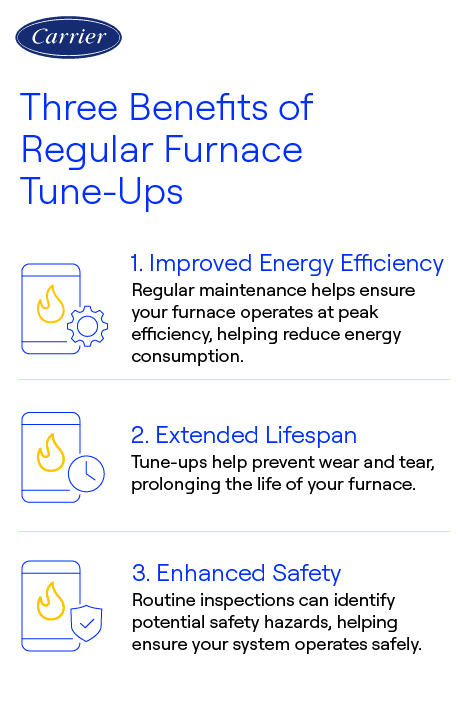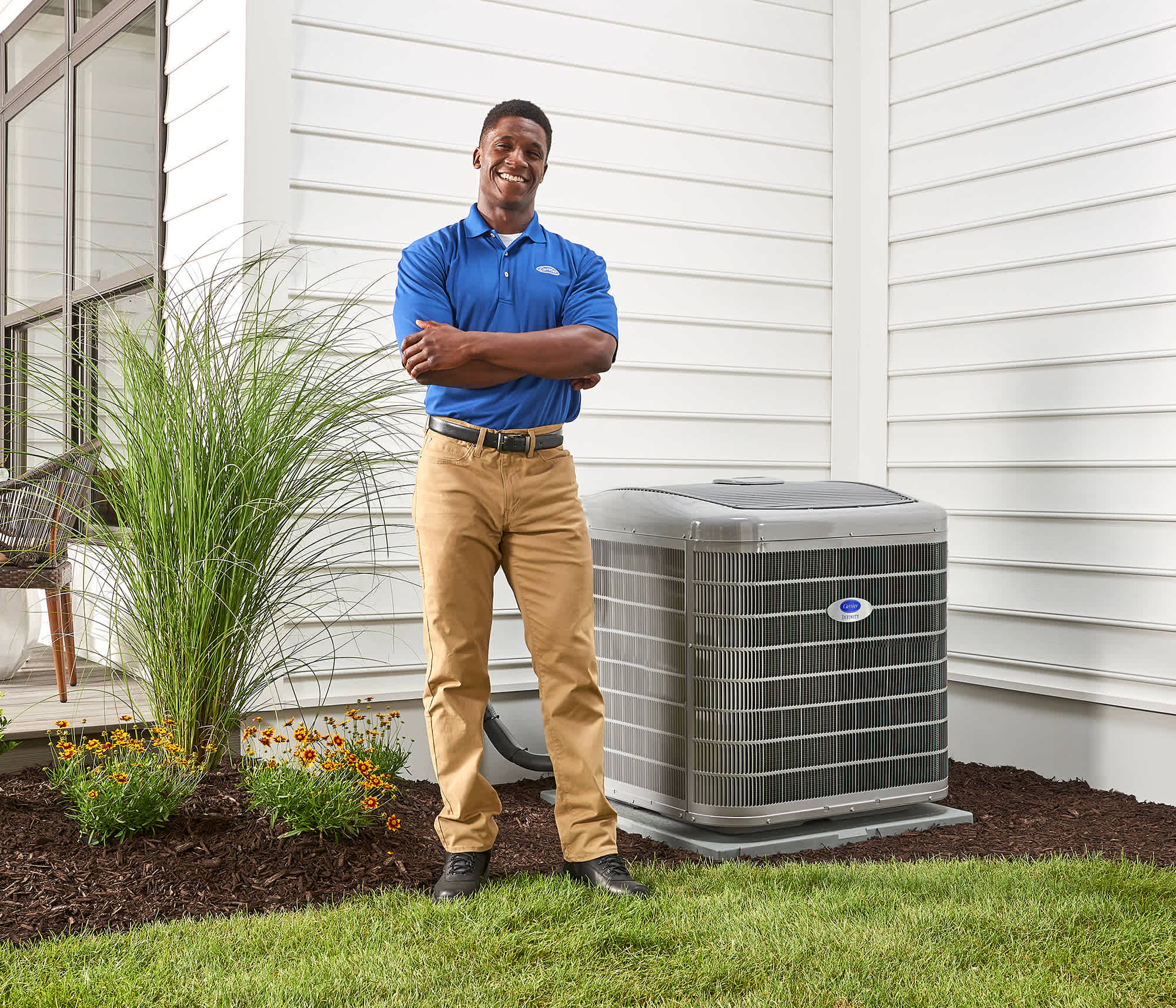Furnace Tune-Up Guide: Everything You Need To Know
If you're searching for a reliable furnace tune-up, look no further. Carrier dealers are ready to provide top-notch maintenance for your furnace, ensuring its optimal performance and longevity. Regular furnace tune-ups offer a range of benefits for homeowners. Not only do they improve energy efficiency, but they can also help prevent unexpected breakdowns. Learn more about furnace tune-ups in this guide and find a local dealer to schedule your tune-up today.

Checklist: 11 Things to Include in a Furnace Tune-Up
During a furnace tune-up, a certified HVAC technician will perform several key tasks to ensure your system operates efficiently and safely. A furnace tune-up checklist is a step-by-step guide that helps technicians systematically inspect, clean, and test all critical components. Following this checklist is a way for a local Carrier dealer to support safety, improve energy efficiency, and extend the life of your heating system, giving homeowners peace of mind throughout the heating season.1. Component Inspection
The technician will inspect the furnace’s components, including the blower, heat exchanger, burners, electrical connections, and venting system, to identify any signs of wear or potential issues.
2. Cleaning
The furnace, burners, and other key components are cleaned to remove dust, dirt, and debris that can affect performance.
3. Filter Check/Replacement
The air filter will be checked and replaced if necessary to maintain proper airflow and improve indoor air quality.
4. Lubrication
Moving parts like the blower motor and fan are lubricated to reduce friction and prevent wear.
5. Safety Check
The technician will check safety controls, test for carbon monoxide leaks, and ensure the system is venting properly to avoid hazardous conditions.
6. Thermostat Calibration
The thermostat will be checked for accuracy and recalibrated if necessary to ensure proper temperature regulation.
7. Combustion Analysis
During a furnace tune-up, the technician tests the air-fuel mixture to ensure the furnace burns fuel efficiently and safely, helping reduce energy costs and minimize harmful emissions.
8. Ductwork Inspection
The technician will examine your ductwork for leaks, blockages, or damage, ensuring air flows efficiently throughout your home and helping maintain consistent comfort and lower energy costs.
9. Performance Testing
The system will be tested to ensure it heats effectively and operates efficiently, including cycling the furnace on and off to verify proper operation.
10. System Efficiency Check
The technician may measure combustion efficiency to ensure the furnace is operating at optimal levels, reducing energy consumption and costs.
11. Report and Recommendations
After the tune-up, the technician will provide a report of findings and may recommend repairs or part replacements to avoid future issues.
Three Benefits of Regular Furnace Tune-Ups

1. Improved Energy Efficiency
2. Extended Lifespan
3. Enhanced Safety
When Should You Schedule a Furnace Tune-Up?
Scheduling a furnace tune-up at the right time ensures your heating system operates efficiently, safely, and reliably. The best time to schedule a professional inspection and maintenance service is before the start of the heating season, typically in early fall. This proactive approach helps identify and address potential issues before cold weather arrives, ensuring your furnace runs smoothly when you need it most.
Another key time to schedule a tune-up is after any major repairs or component replacements. If your furnace recently had parts like the blower motor, heat exchanger, or ignition system replaced, a follow-up inspection ensures everything is working properly and efficiently.
How Often Should a Furnace Tune-up Be Performed?
For long-term performance, a furnace tune-up should be performed at least once a year. Annual maintenance helps extend the system’s lifespan, improves energy efficiency, and prevents costly breakdowns. A well-maintained furnace not only provides consistent warmth but also enhances indoor air quality and safety by reducing the risk of carbon monoxide leaks or system failures.
Regular tune-ups keep your furnace in peak condition, saving you money on energy bills and repairs while ensuring comfort throughout the heating season.
What Does a Furnace Tune-Up Cost?
A typical furnace tune-up usually ranges from $70 to $200, though more comprehensive services or annual service plans can cost between $150 and $500. The exact price depends on several factors, including the type of furnace, the scope of service, and regional labor rates. For example, a standard inspection of a gas furnace may cost less than a full tune-up that includes filter replacement or testing of all components. Some HVAC contractors also offer annual service plans that bundle multiple tune-ups and priority service for a flat yearly fee.
Factors that influence furnace tune-up costs include:
- Fuel Type: Gas, oil, and electric furnaces require different procedures, equipment, and parts, which can affect pricing.
- Labor Rates: Technician hourly rates vary by experience and company, with licensed professionals typically charging more for their expertise.
- Location: Costs can differ depending on your city or region due to local market rates and demand for HVAC services.
- Contractor’s Pricing Model: Some companies charge a flat fee per tune-up, while others bill by the hour or include additional fees for extra services.
- Condition of the Furnace: Older or poorly maintained systems may need more time and parts during a tune-up, increasing the overall cost.
DIY Furnace Maintenance Tips
Proper DIY furnace maintenance helps improve efficiency, extend the system’s lifespan, and prevent costly repairs. DIY furnace maintenance tips include:
- Changing furnace filters: A clogged filter restricts airflow, making the furnace work harder, leading to higher energy bills and potential breakdowns. Replace filters every 1-3 months, depending on usage and indoor air quality.
- Keeping the surrounding area clean and clear: Ensure at least three feet of clearance around the furnace, removing dust, debris, or flammable materials like boxes and paper. This helps with proper ventilation and reduces fire risks.
- Monitoring thermostat settings: Ensure your thermostat is set to an appropriate temperature, and avoid frequent adjustments, which can strain the furnace. If you have an older thermostat, consider upgrading to a programmable or smart thermostat for better efficiency and control.
While these DIY tips help maintain furnace performance, it’s still important to schedule annual professional inspections to catch issues that require expert attention. Regular maintenance keeps your furnace running efficiently, improving comfort and reducing energy costs throughout the heating season.
Find a Carrier Expert for a Furnace Tune-Up Near You

Frequently Asked Questions About Furnace Tune-Ups
- How Much Does it Cost to Replace vs Repair a Furnace?
- Guide to Gas Furnaces
- Furnace Repair & Service
- How Do Gas Furnaces Work?
- Cost Of A Gas Furnace
- Gas Furnace Replacement
- Read about gas furnace repair
- Learn about furnace installation
- What is a high-efficiency gas furnace and how can it benefit me?
- 10 things to consider when buying a furnace
- Furnace troubleshooting tips
- Learn what to do if your furnace is leaking water
- How long does a furnace last?
- Comparing types of furnaces
- AFUE Rating (Annual Fuel Utilization Efficiency)
- Evaluating a Heat Pump vs Furnace
- Burning Smell in House? Causes and How to Fix It
- Learn the causes of a furnace not kicking on
- Learn about different HVAC system types

